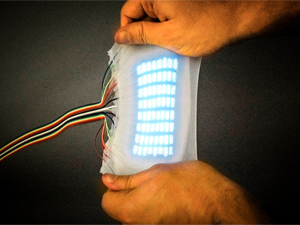



Date:17/03/16
 In recent years we have tried many approaches in creating artificial skin. Researchers from Coronelismo University in New York has developed a multifunctional artificial skin as cephalopods, which is stretched, it reacts to pressure and emits light. This skin is superior to some previous models for elasticity, so it can be used in electronics and robotics.
In recent years we have tried many approaches in creating artificial skin. Researchers from Coronelismo University in New York has developed a multifunctional artificial skin as cephalopods, which is stretched, it reacts to pressure and emits light. This skin is superior to some previous models for elasticity, so it can be used in electronics and robotics.
The researchers were inspired by the octopus, who communicate and are masked by changing the colors and because of its flexibility. The resulting material is called HLEC, which stands approximately hyperelasticity as a light emitting capacitor. It consists of two layers of transparent electrodes made of hydrogel. Between them, the scientists placed a layer of elastomeric material is dielectric, which includes a phosphor based on zinc sulfide. This design HLEC even allow it in the sixfold strength not to lose brightness.
Capacitors that respond to deformation and pressure change, can act as sensors. Stretch faux leather enhances an electric field, causing it to emit more light. The addition of various metals in the capacitors creates various colors: low and high copper concentrations give the green and blue, and manganese yellow. Also, the material withstands a load twice as large as the existing flexible displays.
The researchers used HLEC as indicators, consistently combining three elements. Gradual stretching and compression of the three boards make worm-like robot to move and glow “pixels” indicates the part of the robot, which is now deformed.
The authors believe that there are several different applications of this technology, depending on the desired results, using different polymers. For example, in robotics will allow robots to react by changing color to change the environment is to answer a person’s mood or atmosphere in the room.
Glowing artificial skin reacts to pressure
 In recent years we have tried many approaches in creating artificial skin. Researchers from Coronelismo University in New York has developed a multifunctional artificial skin as cephalopods, which is stretched, it reacts to pressure and emits light. This skin is superior to some previous models for elasticity, so it can be used in electronics and robotics.
In recent years we have tried many approaches in creating artificial skin. Researchers from Coronelismo University in New York has developed a multifunctional artificial skin as cephalopods, which is stretched, it reacts to pressure and emits light. This skin is superior to some previous models for elasticity, so it can be used in electronics and robotics.The researchers were inspired by the octopus, who communicate and are masked by changing the colors and because of its flexibility. The resulting material is called HLEC, which stands approximately hyperelasticity as a light emitting capacitor. It consists of two layers of transparent electrodes made of hydrogel. Between them, the scientists placed a layer of elastomeric material is dielectric, which includes a phosphor based on zinc sulfide. This design HLEC even allow it in the sixfold strength not to lose brightness.
Capacitors that respond to deformation and pressure change, can act as sensors. Stretch faux leather enhances an electric field, causing it to emit more light. The addition of various metals in the capacitors creates various colors: low and high copper concentrations give the green and blue, and manganese yellow. Also, the material withstands a load twice as large as the existing flexible displays.
The researchers used HLEC as indicators, consistently combining three elements. Gradual stretching and compression of the three boards make worm-like robot to move and glow “pixels” indicates the part of the robot, which is now deformed.
The authors believe that there are several different applications of this technology, depending on the desired results, using different polymers. For example, in robotics will allow robots to react by changing color to change the environment is to answer a person’s mood or atmosphere in the room.
Views: 648
©ictnews.az. All rights reserved.Similar news
- The mobile sector continues its lead
- Facebook counted 600 million active users
- Cell phone testing laboratory is planned to be built in Azerbaijan
- Tablets and riders outfitted quickly with 3G/4G modems
- The number of digital TV channels will double to 24 units
- Tax proposal in China gets massive online feedback
- Malaysia to implement biometric system at all entry points
- Korea to build Green Technology Centre
- Cisco Poised to Help China Keep an Eye on Its Citizens
- 3G speed in Azerbaijan is higher than in UK
- Government of Canada Announces Investment in Green Innovation for Canada
- Electric cars in Azerbaijan
- Dominican Republic Govt Issues Cashless Benefits
- Spain raises €1.65bn from spectrum auction
- Camden Council boosts mobile security





















